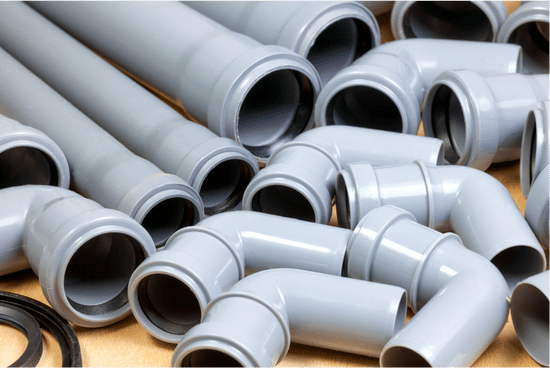
Properties and Overview of POM (Polyoxymethylene)
Overview:
 POM (Polyoxymethylene) also commonly called acetal, is a high-performance engineering thermoplastic known for its excellent mechanical strength, dimensional stability, and low friction. With a combination of stiffness, wear, and chemical resistance, POM is widely used in applications requiring precise, durable components. Its unique properties make it a versatile material for industries such as automotive, electronics, and consumer goods.
POM (Polyoxymethylene) also commonly called acetal, is a high-performance engineering thermoplastic known for its excellent mechanical strength, dimensional stability, and low friction. With a combination of stiffness, wear, and chemical resistance, POM is widely used in applications requiring precise, durable components. Its unique properties make it a versatile material for industries such as automotive, electronics, and consumer goods.
Production:
Polymerizing formaldehyde or its derivatives, such as trioxane, using specialized catalysts produces POM. This process creates a highly crystalline polymer with a smooth, low-friction surface and robust thermal and chemical properties. POM is available in two main types: homopolymer and copolymer. Homopolymer POM offers slightly higher strength and rigidity, while copolymer POM has better thermal stability and resistance to degradation. POM can be processed through injection molding, extrusion, and machining, creating complex, high-precision components.
Applications:
POM is widely used across various industries due to its durability and low coefficient of friction. In the automotive sector, it is employed for gears, fuel system components, door locks, and bushings, where its wear resistance and dimensional stability ensure reliable performance. The electronics industry relies on POM for connectors, switches, and housings, benefiting from its insulating properties and moisture resistance. POM is used for consumer goods such as zippers, fasteners, and kitchenware, taking advantage of its toughness and ease of molding. Additionally, POM finds applications in industrial machinery, where its self-lubricating properties reduce wear in sliding and rotating parts. Its compatibility with precision machining makes it popular for producing custom components and prototypes.
Summary:
Polyoxymethylene is a versatile and durable polymer with a unique combination of strength, low friction, and chemical resistance. Its ability to maintain performance under mechanical stress and challenging conditions makes it a critical material in modern engineering and manufacturing. As industries prioritize reliable and high-performing materials, POM remains essential for various applications, from automotive systems to consumer products. Its enduring relevance underscores its importance as a cornerstone material in innovative design and production.
See a comprehensive list of electrical, mechanical, physical and thermal properties for POM (Polyoxymethylene) below:
Electrical Properties of POM (Polyoxymethylene)
| Electrical Property (Units) | Value |
|---|---|
| POM (Polyoxymethylene) Dielectric Constant at 'Standard Temperature and Pressure' | 3.7 to 4.0 |
| POM (Polyoxymethylene) Electrical Breakdown Voltage at Atmospheric Pressure (kV/mm) | ~15 to 20 |
| POM (Polyoxymethylene) Electrical Conductivity (S/m) | 1.00E-15 to 1.00E-13 |
| POM (Polyoxymethylene) Electrical Resistivity at Room Temperature (25°C) (Ω·m) | 1.00E+13 to 1.00E+15 |
| POM (Polyoxymethylene) Magnetic Property | N/A |
| POM (Polyoxymethylene) Superconducting Transition Temperature (K) | N/A |
| POM (Polyoxymethylene) Temperature Coefficient of Resistance (°C⁻¹) | Unknown |
Unfamiliar with a property? Click it's description to be given a full definition in the GLOSSARY
See properties and overview for
ALLOYS and CHEMICAL ELEMENTS
popular in engineering
Require different units not displayed?
CONVERT VARIOUS UNITS HERE
Mechanical Properties of POM (Polyoxymethylene)
Unfamiliar with a property? Click it's description to be given a full definition in the GLOSSARY
See properties and overview for
ALLOYS and CHEMICAL ELEMENTS
popular in engineering
Require different units not displayed?
CONVERT VARIOUS UNITS HERE
Physical Properties of POM (Polyoxymethylene)
Unfamiliar with a property? Click it's description to be given a full definition in the GLOSSARY
See properties and overview for
ALLOYS and CHEMICAL ELEMENTS
popular in engineering
Require different units not displayed?
CONVERT VARIOUS UNITS HERE
Thermal Properties of POM (Polyoxymethylene)
Unfamiliar with a property? Click it's description to be given a full definition in the GLOSSARY
See properties and overview for
ALLOYS and CHEMICAL ELEMENTS
popular in engineering
Require different units not displayed?
CONVERT VARIOUS UNITS HERE
 ADDED TO MY FAVORITES!
ADDED TO MY FAVORITES! REMOVED FROM MY FAVORITES!
REMOVED FROM MY FAVORITES!